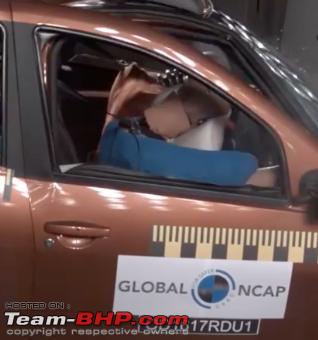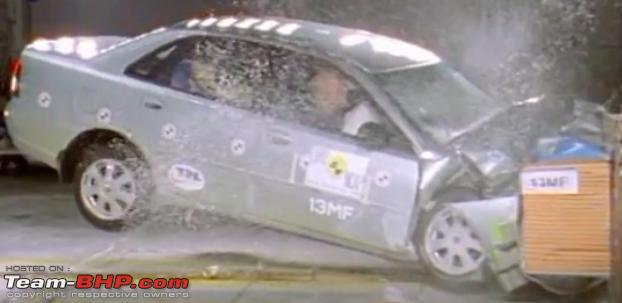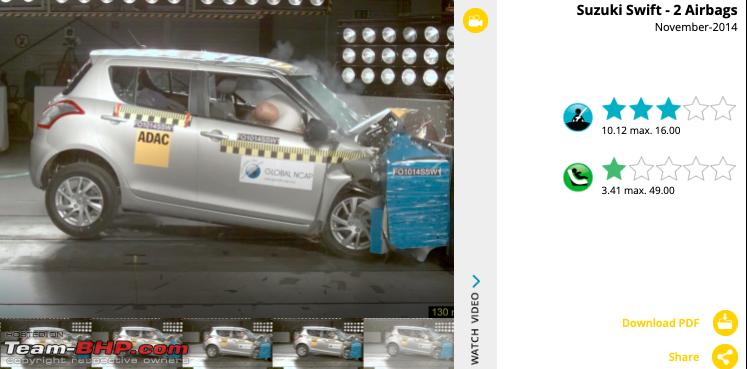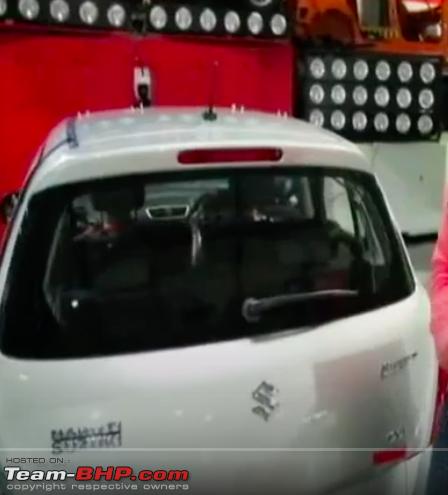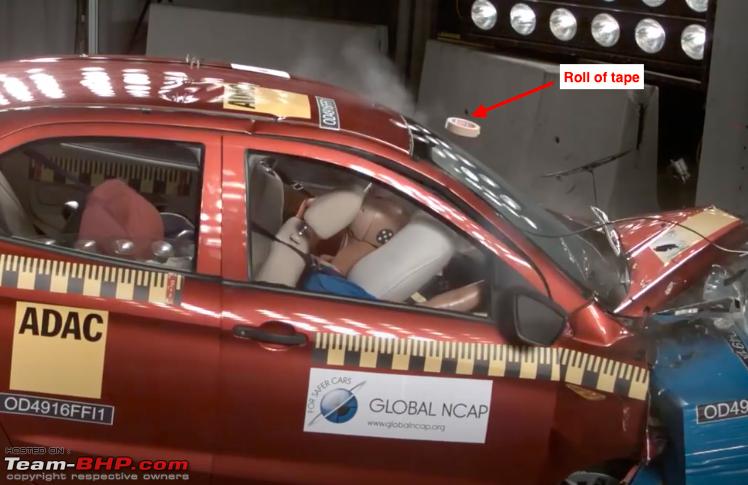| |||||||
| Search Forums |
| Advanced Search |
| Go to Page... |
 |
| Search this Thread |  72,563 views |
| | #1 | |
| Senior - BHPian Join Date: Nov 2019 Location: India
Posts: 1,536
Thanked: 8,008 Times
| Global NCAP crash tests | Broken down & explained It’s been seven years since Global NCAP started its Safer Cars for India project and the market has come a long way since then. Not only do we now have minimum regulatory crash tests for homologation, for front (offset and full-width) and side impact and pedestrian protection, but we have also seen some excellent safety performances, including a number of five star cars for adult occupant protection, and we’re now waiting for the first five star rating for child occupant protection too. I’m going to describe the entire process to the best of my knowledge and hopefully clear some lingering questions. What is Global NCAP? (besides the standard PR talk on their website) Global NCAP is a project of the Towards Zero Foundation (a UK-registered charity). This might sound funny, but initially, it was not an NCAP at all. It was primarily founded to serve as a platform for cooperation among all NCAPs (and the IIHS) and to provide support for new NCAPs in emerging markets, like ASEAN NCAP and Latin NCAP. Since 2014, Global NCAP’s Safer Cars for India project has functioned as an NCAP by itself. They have a small team and their PR is handled by a UK company called Advocacy Impact. While I trust that the data provided by the test lab is accurate, Global NCAP's PR team does make quite a few mistakes in their publications and press releases, which creates some confusion for consumers and reviewers. The most recent effect is that the integrity of the tests has come under question, which is definitely something unacceptable for the very organisation that gives us an important part of information about the safety of the cars we buy. Next year, Global NCAP will be relaunched as a partnership instead of a project. How the cars are selected, purchased and tested There is some ambiguity in this regard because Global NCAP has not published its Car Sponsorship, Selection, Testing and Retesting (CSSTR) Protocol for consumers to view, so I’m going to pen down my observations based on usual NCAP CSSTR protocols and Global NCAP's statements. Non-voluntary testing
Sponsored testing
Which trim level is tested? When Global NCAP tests a model, they pick a variant that is specified with the basic safety equipment available for the model at the time of the test. In addition, the manufacturer may sponsor a test on a model equipped with optional safety equipment to demonstrate its benefits, like the Volkswagen Polo, Renault Duster and Kwid, and the Honda Mobilio. 'Basic safety equipment' does not necessarily imply 'base variant' (another probable goof by their PR team). Disclaimer: Since Global NCAP protocols are usually very similar to older Latin NCAP protocols, I will be using some old Latin NCAP references in cases where a Global NCAP protocol is unavailable. There have been numerous cases where a high variant (but with basic safety equipment) has been tested. Autocar keeps claiming that it has something to do with alloy wheels, but there is no evidence for this except a vague statement by Tata Motors' CTO. I think manufacturers sponsor a higher variant in order to use it in publication (since a variant with steel wheels and black handles and mirrors would not look good in publication images), however, I have no evidence for my claim either. However, Latin NCAP's 2016 CSSTR protocol clearly states that wheels are not considered safety equipment: Quote:
Last edited by ron178 : 27th November 2021 at 06:57. | |
| |  (37)
Thanks (37)
Thanks
|
| The following 37 BHPians Thank ron178 for this useful post: | 5252rpm, ashutoshb, Bibendum90949, BigBrad, carhead, CEF_Beasts, Evyas, Falcon91, fiat_tarun, GaryTSI, GST, GTO, janakiram_m, krishnakumar, lemedico, Maky, mallumowgli, neel@makrand, NoLurkerForLong, ph03n!x, PrasunBannerjee, RavenAvi, RBalaM, Rehaan, Roy.S, rpm, shancz, sierrabravo98, Sreejith V, SRT_Dwarka, superguy282, Tgo, The Rationalist, theexperthand, Turbanator, whitewing, ysjoy |
| |
| | #2 |
| Senior - BHPian Join Date: Nov 2019 Location: India
Posts: 1,536
Thanked: 8,008 Times
| re: Global NCAP crash tests | Broken down & explained The Frontal Offset Test ProtocolAt present, the Global NCAP assessment is primarily based on a frontal crash test into an offset deformable barrier at 64±1km/h, whose test protocol is similar to that used by most other NCAPs. The test protocol is standardised and is intended to enable a fair assessment with uniform test configuration for cars regardless of size or class, to produce repeatable results. There is very little room for ambiguity. The test configuration is identical to 2013 Latin NCAP protocol, which is what I have used for reference. Before we start, let's get familiar with the types of dummies used:
I will be explaining a few salient points directly from the test protocol. Some of them have mathematical systems that I have not yet been able to comprehend, so I would request anyone interested to please read the protocol directly. This post is mainly composed of a simplified interpretation of some relevant points from the test protocol. The test protocol can be found here. Unladen kerb mass The test lab first finds the unladen kerb mass of the car (different from test mass) as defined in the test protocol. -The fuel is emptied out -Using the manufacturer's specified fuel tank capacity, the mass of ballast to be filled is calculated using a density of 0.745g/cc for petrol and 0.840g/cc for diesel -Engine oil and other fluids are topped up -The spare wheel and all tools supplied with the car are kept in the car, and nothing extra -Tyre pressures are maintained according to manufacturer instructions for half-load -The unladen kerb mass is calculated using front and rear axle masses Reference mass The following method is used to calculate reference mass: -90% of the ballast in the fuel tank (calculated in the previous section) is left in the vehicle -The front and rear seats are placed in the middle fore-aft and height (if available) positions -A mass of 88kg (the mass of a Hybrid III 50th percentile dummy) with the instrumentation and cabling) is placed in each of the front seats -Masses of 15kg in place of the Q3 dummy and 11kg for the Q1.5 dummy are placed in the respective rear seats in the child restraints specified by the manufacturer -The reference mass is calculated using front and rear axle masses Offset -The vehicle width at its widest point is calculated, excluding ORVMs, mud flaps, etc. -The centre line is marked with tape and 10% of the distance between this and the widest point is calculated. This distance left of the centre line (for RHD cars) is marked with tape, and this is the position where the edge of the offset deformable barrier meets, making for 40% offset 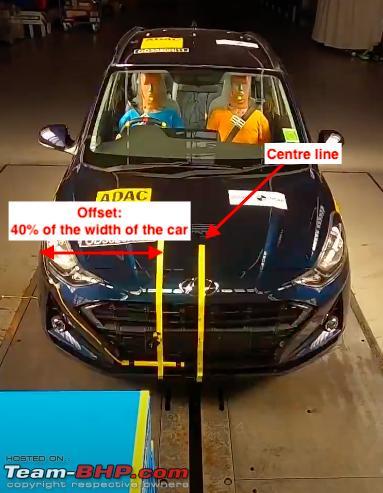 Centre line and offset marking on a test car - the Hyundai Grand i10 Nios Vehicle Preparation -The battery must be connected to the electrical circuit. There are detailed instructions for additional batteries -In case fluids must be drained they must be replaced by suitable noncombustible ballasts of similar density -Thoughtfully, it is not allowed to vent HVAC fluids to the atmosphere -An abort system is optional -The boot carpeting is removed, and the spare wheel is removed if it is deemed that it will not affect crash performance. Test mass -The on-board data recording equipment is placed in the boot and the mass of the car is measured as in the reference loads section. If this mass exceeds reference mass by more than 5% or 20kg (whichever is less), non-structural parts are removed to adjust it -This is the mass of the car with dummy dummy* masses, child restraints, ballast and recording equipment installed. -The test mass is calculated using front and rear axle masses using the method specified under 'reference loads', and is specified in the test report published by Global NCAP  Test mass specified in the test report for a Toyota Etios This is a common question on the internet and it has been said time and again - the test mass is not the kerb mass. *not a typo Markings and labels -Global NCAP labels in English are attached on the top half of the driver and passenger doors and on the front half of the roof -Test lab logos may be added to the lower half of the rear doors and to the hood at the base of the windscreen 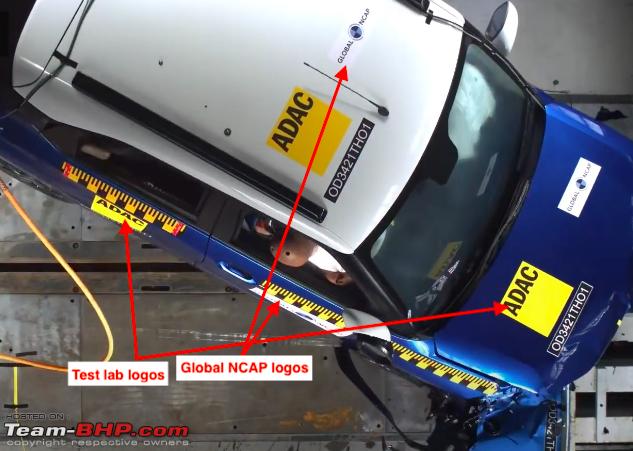 NCAP and test lab markings on a Tata Punch -The rear doors of the vehicle are marked on the interior and exterior for lengths of at least 400-600mm in 50mm increments so that forward excursion of the child dummies can be measured, and the on the exterior of the front door similar markings are attached to assess movement of the front dummies on the high-speed film (for example, for unstable contact on a steering wheel or on an airbag)  Markings showing excursion of the Q3 dummy in a Honda Amaze 3D measurement system -This is rather complex so I would advise anyone interested to view the attached Latin NCAP test protocol -There is a measurement system that is based on fixed reference points on parts of the car that are not expected to deform and there are coordinate axes defined. This is mainly used to determine A-pillar displacement, pedal movement, steering column movement and dummy excursion Dummy preparation -The adult dummies are certified after every three tests according to the provisions of UNECE Reg. 94 -Child P-series dummies were certified after every six tests but I am not sure about Q-series dummies -Clothing and footwear to be fitted to dummies is specified in the protocol -The dummies must be soaked in a temperature of 19-22ºC for at least 5 hours before the test and upto a maximum of 10 minutes before the test -Stiffness of dummy joints is set by a qualitative method -Masking tape of specified size is applied to various regions of the dummies and paint of specified colour is applied to it just before the test to make sure it is still wet on impact  Wet yellow paint being applied to the forehead of the Q3 in a Mahindra Marazzo a few minutes before the test Dummy and vehicle instrumentation -Please see test protocol for details -Sensors are fitted in the dummies which record different physical parameters for different body regions -Accelerometers are fitted to the B-pillar of the vehicle -Seatbelt loadcells are fitted to the shoulder area 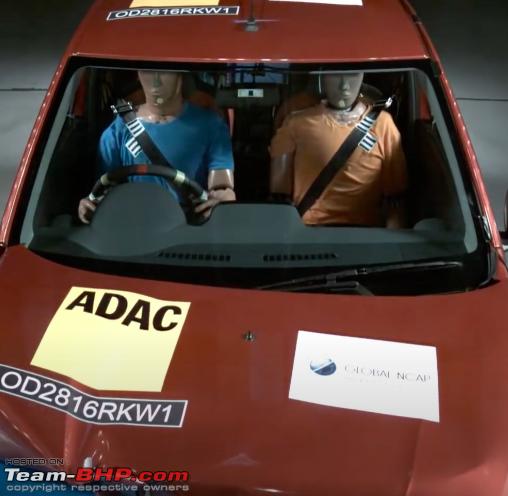 Seatbelt loadcells visible above the shoulder area in a Renault Kwid after pretensioner deployment, with pretensioner deployment indicated by separation of the pieces of paper at the chest area 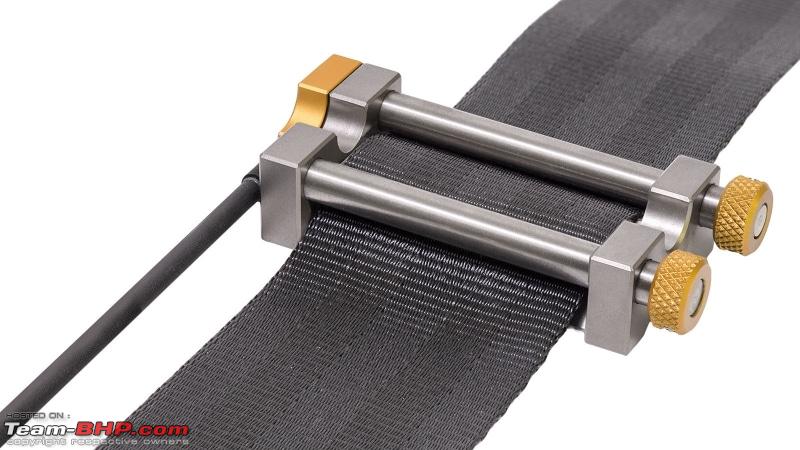 A seatbelt loadcell Camera location -Ten camera positions are mandatory, out of which some are displayed in the test video -Look at the bottom left of the test video to find out which camera you are viewing -The high-speed cameras must meet Euro NCAP requirements 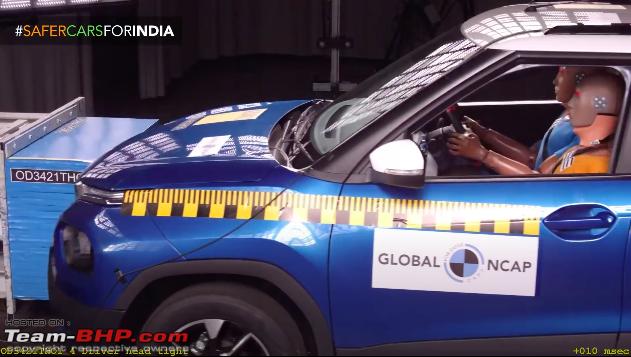 Bottom left: Camera view specified in a published test video for the Tata Punch, here: 'Driver head tight' Passenger compartment adjustments -Seat fore-aft adjustments, head restraints, adjustable steering columns, adjustable pedals and other available adjustments in the passenger compartment must be set according to protocol. Some of these are as recommended by the manufacturer, and if the manufacturer fails to recommend positions there are default cases considered. -A 'Gabarit' is used to determine compatibility of Universal CRSs, and more information about this can also be found in the assessment protocol for Child Occupant Protection. Dummy positioning in the seats -If the vehicle has never been sat in then a person of mass 75±10kg must sit in the driver and passenger seat twice each for 1 minute to flex the cushions. -The dummy must not be placed in the seat for more than 2 hours to prevent unnecessary compression of the seat. -An H-point machine is used to determine the H-point of the seat which is used to define the position where the dummy will sit. Refer protocol for more details -If adjustable, the upper seatbelt anchorage should be positioned in the position the manufacturer specifies for a 50th percentile male (if not, a default case is used). There are other similar adjustments for the seat belt. -Child restraints are based on manufacturer recommendation and there are further instructions. Please see protocol. The test -The offset deformable barrier test uses the standard deformable barrier, which will be covered later. -The barrier is placed at 200±5mm above the ground -The overlap is 40%±20mm -The test speed is 64±1km/h and must be stabilised for a given distance before impact The barrier The deformable barrier is made of an aluminium honeycomb and is composed of a main honeycomb block (that represents the longitudinal crash members (crumple zone) of the opposing car and a protruding bumper element. The materials, adhesives, crush strengths and honeycomb shapes and spacing are specified. The barrier must be certified according to an NHTSA protocol before use. Due to the large number of crash tests that occur throughout the year, these barriers are usually purchased in bulk from manufacturers (like Argosy International). 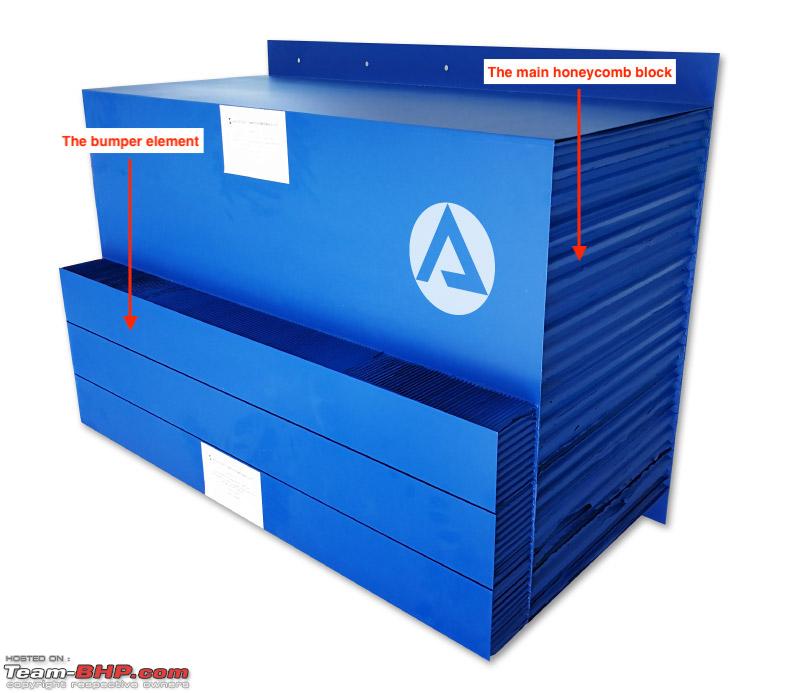 Please be reminded that the above is only a concise explanation of the actual test protocol. For complete information, read the test protocol linked above. Last edited by ron178 : 26th November 2021 at 11:23. Reason: broken [B] tags |
| |  (33)
Thanks (33)
Thanks
|
| The following 33 BHPians Thank ron178 for this useful post: | BigBrad, CEF_Beasts, d3mon, Evyas, fiat_tarun, GaryTSI, Gaur, GST, GTO, Hayek, Keeleri_Achu, lemedico, Leoshashi, Maky, mallumowgli, neel@makrand, NoLurkerForLong, ph03n!x, RavenAvi, RBalaM, Rehaan, rpm, shancz, sierrabravo98, SRT_Dwarka, superguy282, Tgo, theexperthand, Torque_Curve, Turbanator, Vasanth, whitewing, ysjoy |
| | #3 | |||
| Senior - BHPian Join Date: Nov 2019 Location: India
Posts: 1,536
Thanked: 8,008 Times
| re: Global NCAP crash tests | Broken down & explained Assessment for adult occupant protectionThe assessment protocol for adult occupant protection in Global NCAP tests is available on their website. To make it slightly more readable, I'll try to break it down here. The adult occupant protection score is based on a sum of two scores: 16.00 for the frontal offset test (whose configuration is mentioned above) and 1.00 for front seatbelt reminder assessment. Seatbelt RemindersThe seatbelt reminders in the front seating positions are assessed in accordance with the seatbelt reminder section of Euro NCAP Safety Assist Protocol - version 5.6. Points are awarded for every front seating position on a pass/fail basis. If there are n front seating positions then every position carries 1.00/n point. For example, a 5-seater Toyota Etios would carry 0.5 points for every front seating position but a 6-seater Mahindra KUV100 would carry 1/3 point for every front seating position. A criterion for qualifying for seatbelt reminder assessment is that the head, neck and chest of the driver and passenger have final scores of more than 1.333 out of 4.000. Assessment for the frontal offset testThe frontal offset test, more specifically the front offset deformable barrier test (hereby referred to as the ODB test or the offset test or the frontal impact) presently forms the major portion of the assessment for adult occupant protection. The total score for the offset test is 16.00. This comes from the scores obtained for 4 different groups of body regions: Head and neck: 4.000 Chest: 4.000 Knee, femur and pelvis: 4.000 Lower legs (tibias and drivers' feet): 4.000 The total score is rounded down to two decimal places. The score for each individual body region is displayed in a visualised set of driver and passenger dummies in the test report. The colour coding is as follows: Green: 4.000 points (good) Yellow: 2.670 - 3.999 points (acceptable) (approximately [8/3 to 4)) Orange: 1.330 - 2.669 points (marginal) (approximately [4/3 to 8/3)) Brown: 0.001 - 1.329 points (weak) (approximately (0 to 4/3)) Red: 0.000 points  An example of visualised body region scores for a Honda Amaze The score for each group is the score of the worst performing body region in that group. For example, if the driver's head and neck and the passenger's head have scored 4.000 points, but the passenger neck has scored 0.486 points, then the score for the 'head and neck' group is 0.486 out of 4.000. To put it in another way - an apt example of the proverb "A chain is only as strong as its weakest link". Star rating for adult protectionTo calculate the final star rating for adult protection:
How is a body region scored? The score for a body region is determined based on: -biomechanical injury readings -modifiers (separate score reductions) To find the score based on biomechanical injury readings, a so-called 'sliding scale' system is used. A key preliminary here is to understand that a lower injury reading means higher performance. So, when I say 'higher performance' it means lower injury and vice versa. For every body region there exists a 'lower performance limit' and a 'higher performance limit' for biomechanical injury readings (the parameter used varies by body region). If the injury reading is less than the higher performance limit (which is a lower injury value), then the region is awarded the full 4.000 points (green) initially. If the injury reading is above the lower performance limit (which is a higher injury value) then the region is awarded 0.000 points (red) initially. If the value is between these limits then simple linear interpolation is used to determine the scores. For some body regions there is more than one injury parameter used. In this case, the lowest of the scores obtained by interpolating each parameter is used. Here is the 'sliding scale' system represented graphically:  The system used to determine injury-based score for body regions The score calculated by interpolating injury measures is not the final score for the body region. Global NCAP applies 'modifiers' to every body region. These modifiers indicate that there might be a difference in performance under test conditions that slightly deviate from the protocol, like a different seating style, slightly higher speed, less overlap etc. and hence the car loses points. Modifiers are specific to a body region. I will be specifying higher and lower performance limits respectively in square brackets in bold next to each parameter. For example, [22mm, 50mm] Where there are multiple injury parameters for a body region the lowest of the scores obtained by interpolating each of them is used. Head Injury parameters:
Modifiers:
Neck Injury parameters:
None Chest: Injury parameters:
Modifiers:
Knee, Femur And Pelvis: Injury parameters:
Modifiers:
Removal of knee modifiers: The modifiers for the knee region are subject to testers' judgment and hence the benefit of doubt must be given to the manufacturer. For this, the manufacturer is allowed to demonstrate by means of a test that the structures in the dashboard that caused the variable contact/concentrated loading modifiers to be applied do not pose a risk to the knees. The body-in-white is mounted on a sled and is accelerated rearward using a defined pulse, and the protocol (and the pulse used) can be found on the Euro NCAP website. If certain performance requirements are met in the sled test, the knee modifiers may be removed. Quote:
 Removal of knee modifiers for the Tata Nexon along with addition of a passenger side seatbelt reminder allowed it to reach a comfortable five star score. See discussion (Tata Nexon: Global NCAP’s first 5-Star Indian car). Lower Legs (tibias) Injury parameters:
Modifiers:
Driver's feet Injury parameters:
Assessment for child occupant protectionThe assessment protocol for child occupant protection is more complex to understand and includes various factors like CRS installation, labelling and marking, and the dynamic test itself. I do not personally have a good understanding of the child occupant protection assessment protocol yet but hope to do so soon, and I will update this thread if and when I acquire this knowledge. It is important to note that starting August 2017, Q-series dummies have been used for Safer Cars for India and before it P-series dummies were used. For Safer Cars for Africa Q-series dummies have always been used. Last edited by ron178 : 27th November 2021 at 06:58. Reason: Defining hard contact as peak Ar > 80g | |||
| |  (21)
Thanks (21)
Thanks
|
| The following 21 BHPians Thank ron178 for this useful post: | Bibendum90949, CEF_Beasts, d3mon, Evyas, fiat_tarun, GaryTSI, GTO, Leoshashi, mallumowgli, NoLurkerForLong, PetrolheadRup, ph03n!x, RavenAvi, RBalaM, Rehaan, rpm, superguy282, Tgo, theexperthand, Turbanator, whitewing |
| | #4 | |||
| Senior - BHPian Join Date: Nov 2019 Location: India
Posts: 1,536
Thanked: 8,008 Times
| re: Global NCAP crash tests | Broken down & explained The elusive fifth starThe coveted fifth star for adult occupant protection is special, and for a number of reasons. The criteria for qualifying for a five star rating are:
Hence, for consumers, a five star car is highly recommended where possible, even over a four star car. A four star car has unverified side impact performance and its performance in future tests (with graded side impact) becomes questionable. While passing R95 is not necessarily indicative of good side impact performance, it is an indicator that the car has at least a minimum standard of side impact performance. While the ARAI's AIS-099 side impact test is modelled on R95, there are some differences in the clauses. The Safer Choice AwardIn February 2018, Global NCAP announced its Safer Choice India Award, which indicates performance in additional categories besides five stars for adult protection (and four for child protection), namely Electronic Stability Control and Pedestrian Protection (headform and legform impactor tests). To qualify for a Global NCAP ‘Safer Choice’ Award, a car model must achieve all of the following requirements: Quote:
The relevant test protocols for ESC (Global Technical Regulation 8) and pedestrian protection (GTR 9) can be found on the UNECE website. Frequently Asked QuestionsWhere are the tests conducted? In principle, the tests can be conducted at any Global NCAP accredited test laboratory. Presently, their only accredited test laboratory is owned by ADAC. The crash test laboratory (or "crashanlage" in German) is part of the premises of ADAC's technical centre ("Technik Zentrum") in Landsberg am Lech, Germany. You can find out more about it here (use a translator). It is also an accredited test laboratory for Euro NCAP and Latin NCAP. Who funds Global NCAP? Global NCAP is a nonprofit and gets limited funding from its sponsors, namely, the FIA Foundation and Bloomberg Philanthropies. In order to prevent funding from getting in the way of issuing ratings, Global NCAP has a sponsorship program where manufacturers may choose to volunteer to have their models tested, in which case all costs related to the vehicle, transportation, test lab fees etc. must be borne by the manufacturer. The manufacturer is invoiced after publication of results. I'm looking for safety ratings for a car, where can I find them? If Global NCAP hasn't issued a rating, can I use another NCAP's rating? Due to limited funds, Global NCAP is only able to test a few of the popular vehicles on the market every year, besides manufacturer-sponsored tests. Hence, there are currently many vehicles on the market that do not have a rating. This is why Global NCAP is pushing for the establishment of a government-funded Bharat NCAP. In the absence of a rating, it is not possible to predict how a car would perform without actually conducting the test. It is not advisable to use ratings from other NCAPs (Latin NCAP, ASEAN NCAP, Euro NCAP, ANCAP, Japan NCAP, Korea NCAP, C-NCAP, ARCAP, NHTSA, IIHS, Global NCAP's Safer Cars For Africa) for the Indian market, for a number of reasons:
When will Global NCAP update its assessment protocol? Global NCAP will update its assessment protocols in July 2022, with greater importance given to side impact performance, side head protection technologies and electronic stability control. The new protocols can be found here for adult protection and here for child protection. Their introduction was delayed because of COVID-19. Besides this, there was a minor revision in August 2017. If a car has scored five stars under current protocol, how many stars will it score under the new protocol? It is impossible to say without conducting additional tests, however it is possible to determine the maximum possible star rating for a model based on the equipment it is sold with, some of which is a requirement for the higher stars. Are airbags useless when the bodyshell has been rated unstable? Please see Post #3: Chest/Modifiers/Loss of passenger compartment integrity for more details. When there is loss of passenger compartment integrity, it does not necessarily mean that the occupant compartment has collapsed during the test. As for side and curtain airbags, their performance is completely independent of frontal impact performance. Why did Global NCAP test cars without airbags instead of directly awarding them zero stars? Not being equipped with airbags does not directly imply that a car will score zero stars. In fact, there is a separate section of the assessment protocol dedicated to evaluating head protection for cars equipped not equipped with a driver side airbag. While a fair assumption in many cases, it can only be said that a car will score zero stars if this has been demonstrated by means of a test. Is it wrong that Global NCAP is called a 'third party' by some manufacturers? Global NCAP is an independent nonprofit organisation. In the absence of a Bharat NCAP it is true that Global NCAP is a third party. I have seen older Latin NCAP results using the same protocols as Global NCAP where a car has scored one star for adult protection despite having a critical body region marked red. Why is this? Global NCAP adult occupant protection uses the same assessment protocol that Latin NCAP used from 2013-2015. Though the stars were coloured the same, the protocol used by Latin NCAP from 2010-13 was different, and it lacked seatbelt reminder points, certain five star requirements and also did not have capping limits for injury values. Hence, if a body region scored poorly with or without modifiers it was limited to one star, and zero stars was only possible to achieve by achieving a total score less than 4.00 points (like the Geely CK-1). This is different from Global NCAP and 2013-15 Latin NCAP. My car has seatbelt reminders, why does Global NCAP say it doesn't? If any equipment that is assessed on a pass/fail basis, like a seatbelt reminder or a pretensioner, does not meet minimum performance requirements, Global NCAP considers it equivalent to being absent. Why do the videos for newer results have a more blue hue than usual? The ADAC Technik Zentrum crash test laboratory updated its high-speed lighting system in mid-2020. What rating is considered good? Global NCAP does not grade cars on a pass/fail basis. It issues star ratings so that consumers can make an informed choice. In general, Global NCAP strongly discourages the sale of zero and one star cars since they indicate a high risk of life-threatening injury. Global NCAP recommends consumers to purchase a car with the highest possible star rating. Is there monetary influence in the testing? Can manufacturers monetarily influence the rating? Manufacturers may volunteer to pay for a test on their model. In addition, in some cases, some extra tests must be sponsored by the manufacturer regardless of whether the test is voluntary or not, like the R95 side impact test and the knee mapping sled tests for removing knee modifiers. Hence it is not likely that a car will score a full rating without some of the testing being paid for by the manufacturer. The manufacturer is informed of this well in advance of publication and data for the additional tests may be presented at the one-to-one meeting which is held regardless of who sponsors the test. In addition, as can be seen in the test protocol (Post #2), some adjustments that are different for different cars must be recommended by the manufacturer, without which a default case will be considered. The child restraints to be used are also at the discretion of the manufacturer, and if the manufacturer refuses to recommend child restraints, the dynamic testing portion of the child protection score is zero and Global NCAP does not publish performance of the compatible child restraints they have selected. Every manufacturer is informed of the test before it happens and is invited to witness it. Why are zero star cars still legal? Global NCAP is not a regulatory body, and while it makes recommendations for implementation of regulation, it is, by nature, a consumer information program. NCAPs in general always make sure that their minimum requirements for a non-zero rating are slightly above minimum regulatory requirements. Hence it is possible for a car to be on sale that meets the ARAI's AIS-098 and 099 homologation standards but scores a zero star rating in Global NCAP's tests. What do the test codes pasted on the cars mean? These are codes pasted by the test lab to identify tests. See BHPian rpm's post for more details. To recap: First two characters: OD/FO: Offset Deformable Barrier test/Frontal Offset test (no, the cars aren't registered or tested in Odisha though a YouTube user in the Ford Aspire's test video's comments section thinks otherwise) MD/SI: Mobile Deformable Barrier test/Side Impact test PP: Pedestrian Protection test PO: Lateral/Oblique Pole test CC: Car-to-Car test Next two characters: Week in which the test was conducted Next two characters: Year in which the test was conducted Next character: First letter of the manufacturer's name Next two characters: First two letters of the model name Last character: A digit indicating the serial of the test of the same type in the same week, for example, if two side impact tests are conducted on the same model in the same week in the same year, the digit will be '2' and so on. For example, OD0220TAL1 means the first offset deformable barrier test on the Tata Altroz in the second week of 2020. GoofsNo organisation is perfect, but in my opinion, Global NCAP's PR team (Advocacy Impact) has not done a very good job of keeping the press releases accurate. There have been a number of goofs in the press releases, test reports and in general in the data provided by the PR team (not the test lab) and I hope this improves.
Image credits: Hyundai Grand i10 Nios frontal offset test (frontal view) - Global NCAP (YouTube) Toyota Etios Hatch test mass - Global NCAP (website) Tata Punch frontal offset test (plan view) - Global NCAP (YouTube) Honda Amaze frontal offset test (interior Q3 dummy view) - Global NCAP (YouTube) Mahindra Marazzo Q3 dummy headband wet paint - NDTV CarandBike (YouTube) Renault Kwid frontal offset test (frontal view) - Global NCAP (YouTube) Seatbelt loadcell - Messring GmbH (website) Tata Punch frontal offset test (driver tight view) - Global NCAP (YouTube) Argosy International Deformable Barrier - Argosy International (website) Honda Amaze visualised body scores - Global NCAP (website) Sliding Scale illustration - made it myself Renault Duster frontal offset test (driver tight view) - Global NCAP (YouTube) Proton Impian frontal offset test (publication view) - Euro NCAP (website) Proton Impian post-test lower occupant compartment interior - Top Gear (YouTube) Tata Nexon knee modifier removal illustration - Global NCAP (website) Suzuki Swift with double airbags old test report - Global NCAP (via Team-BHP) Tata Altroz R95 test video still - Global NCAP (via Team-BHP) Renault Kwid (IV) with driver airbag and pretensioners old test report - Global NCAP (via Team-BHP) Hyundai i10 test report - Global NCAP (website) Toyota Etios Hatch test report - Global NCAP (website) Maruti Suzuki Swift ZXi star rating - Latin NCAP (website) Maruti Suzuki Swift ZXi (tested by Global NCAP) rear - NDTV CarandBike (YouTube) Roll of tape on Ford Aspire - Global NCAP (YouTube) I'm hoping we can use this thread to further discuss anything regarding Global NCAP protocols exclusively since there currently exists no thread for this. Last edited by ron178 : 27th November 2021 at 07:58. | |||
| |  (73)
Thanks (73)
Thanks
|
| The following 73 BHPians Thank ron178 for this useful post: | --gKrish--, 400notout, anandhsub, Ankur@VNS, aravind.anand, Aravind_M92, audioholic, beast_within, Bibendum90949, Capricorn, Car Stalker, CEF_Beasts, d3mon, Evyas, fiat_tarun, flyingneo, Gaur, giri1.8, GST, GTO, HowardRoark, Hrishi_111, jagzrk, jalex77, jnanesh, Keeleri_Achu, kiku007, KK_HakunaMatata, KVNair, K_Drive, lemedico, Leoshashi, lxskllr, Mahesh Prasad, mallumowgli, ManishSoni, McLaren_P1, Meph1st0, Mohan Mathew A, nagr22, neel@makrand, NoLurkerForLong, padmrajravi, papr23, PetrolheadRup, ph03n!x, PrasunBannerjee, Ptr11s, RavenAvi, RBalaM, Reinhard, Roy.S, rpm, RR96, saikarthik, sainyamk95, Sen, shancz, Shreyans_Jain, sierrabravo98, Sreejith V, sridhar-v, SRT_Dwarka, sumeethaldankar, superguy282, Tgo, The Rationalist, theexperthand, TorqueIndia, Torque_Curve, Vignesh Vee, whitewing, ysjoy |
| | #5 |
| Team-BHP Support  | Re: Global NCAP crash tests | Broken down & explained Thread moved from the Assembly Line to the Safety section. Thanks for sharing! Going to our homepage today  |
| |  (4)
Thanks (4)
Thanks
|
| The following 4 BHPians Thank GTO for this useful post: | jalex77, Reinhard, ron178, Sen |
| | #6 |
| BHPian Join Date: Nov 2020 Location: Pune
Posts: 134
Thanked: 827 Times
| Re: Global NCAP crash tests | Broken down & explained Well, there already is a thread (NCAP tests: Things to keep in mind as a buyer / misconceptions about NCAP) about this, but yours does go into much more detail than mine ever did  . Kudos to you effort! . Kudos to you effort!Now on this topic, I'd like to ask if you could find any sort off information on the Body Shell Integrity rating, and what exactly it means when a car is rated "Unstable". When I was scavenging around for info on GNCAP, I couldn't find any information. Please do post it if you find anything. |
| |  (5)
Thanks (5)
Thanks
|
| The following 5 BHPians Thank superguy282 for this useful post: | jalex77, NerdyMillennial, ron178, Sen, shancz |
| | #7 | |||
| BHPian Join Date: Nov 2020 Location: Mohali
Posts: 216
Thanked: 771 Times
| Re: Global NCAP crash tests | Broken down & explained Quote:
Quote:
PS: Kudos to BHPian ron178 for going through the herculean task of penning down such a comprehensive guide about GNCAP and its test protocols.  Last edited by rpm : 27th November 2021 at 11:56. | |||
| |  (10)
Thanks (10)
Thanks
|
| The following 10 BHPians Thank rpm for this useful post: | Bibendum90949, carhead, giri1.8, jalex77, NerdyMillennial, ron178, sainyamk95, Sen, Sunderdeep, superguy282 |
| | #8 |
| Senior - BHPian Join Date: Jul 2012 Location: Chennai
Posts: 1,763
Thanked: 4,766 Times
| Re: Global NCAP crash tests | Broken down & explained So our Swift ZDi wasn't a tin can afterall, remember being completely disappointed when the results came out for the base version. All this Tin can propaganda surely did take some joy out of our ownership experience. Also would love to see if all 4 star cars are equal is real life performance, let's say Tiago has a head-on collision with Marrazzo, wouldn't the MPV have the weight advantage here? How about 5 Star hatch vs 3 star full size SUV close to 2 tons. |
| |  (5)
Thanks (5)
Thanks
|
| The following 5 BHPians Thank giri1.8 for this useful post: | Hrishi_111, jalex77, KVNair, rpm, sainyamk95 |
| | #9 | |
| BHPian Join Date: Nov 2020 Location: Mohali
Posts: 216
Thanked: 771 Times
| Re: Global NCAP crash tests | Broken down & explained Quote:
Another case where I examined this was on this thread (Crash Test: Big van vs Compact SUV), but it was marred by the lack of availability of a crash rating for the Van. Alternatively, you can save yourself some time and skip the above discussions in favour of these articles from IIHS and EURO NCAP. It is rather difficult to say how a 3-star full size SUV would fare against a 5-star hatch, because I don’t have data I can point to. Also, these tests only consider the frontal offset scenario. Side impact and all other physical tests are still an uncertainty (to me at least). Last edited by rpm : 27th November 2021 at 14:24. | |
| |  (5)
Thanks (5)
Thanks
|
| The following 5 BHPians Thank rpm for this useful post: | Evyas, giri1.8, ron178, sainyamk95, SRT_Dwarka |
| | #10 | |||
| Senior - BHPian Join Date: Nov 2019 Location: India
Posts: 1,536
Thanked: 8,008 Times
| Re: Global NCAP crash tests | Broken down & explained Quote:
Quote:
Quote:
However, if a higher rated small car A and a lower rated larger car B each crash separately into another small car C (that is representative of the deformable barrier) under similar conditions then A would likely perform better than B and that is something we can conclusively say. What we can also say is that in a car-to-car crash where both cars had similar structural performance in a static deformable barrier test, the larger car will likely perform better than the smaller car. There is no 'law of conservation', if you will, for injury in a car-to-car crash. If the occupants in the smaller car sustained fatal injuries that doesn't mean the occupants in the larger car survived, and a larger car having poor structural performance doesn't mean that the occupants of the smaller car are any more likely to survive. The damage inflicted to the smaller car is not highly dependent on the occupant compartment performance of the larger car. Car-to-car crashes are a complex issue and there are a lot of possible combinations that would need to separately be analysed. There is also an issue of bumper misalignment: higher-riding cars often have their bumpers placed higher (unless designed otherwise), and often in a car-to-car crash such cars would inflict large amounts of damage to a smaller car since the longitudinal crash members ("crumple zone") near the bottom of the smaller car would not be engaged. For example, if you take four identical examples S1, S2, S3 and S4 of a small five star model and crash them under identical conditions (that must also be favourable for the data) into four examples of a larger, heavier SUV model L1, L2, L3 and L4 respectively that are identical in mass and size but differ in the following aspects: (i) L1 has poor structural performance in an ODB test and poor crash compatibility with the smaller car S1 (ii) L2 has poor structural performance in an ODB test but good crash compatibility with the smaller car S2 (iii) L3 has good structural performance in an ODB test but poor crash compatibility with the smaller car S3 (iv) L4 has good structural performance in an ODB test and good crash compatibility with the smaller car S4 Then the probability of injury to the occupants in L3=L4>L1=L2 and the probability of injury to the occupants in S4=S2>S1=S3 (= refers to approximately equal, probably insignificantly more in one case than the other) The offset deformable barrier test does not assess crash compatibility at all. The only programme that includes this in consumer test protocol is Euro NCAP, who introduced a mobile progressive deformable barrier test in 2020, in which the barrier moves towards the car too and the damage to the barrier is also measured using a 3D system and hence vehicle compatibility is included in the evaluation. To conclude, crashing one car into the other is not regarded the best way of comparing their performance. For your reference I'll attach an old technical paper about the applicability of offset deformable barrier test results to real-world car-to-car crashes here. Keep in mind that it uses Swedish data. I do remember coming across a paper (if I remember correctly it was composed by current Euro NCAP president Dr Michiel van Ratingen during the development of the offset deformable barrier quite long ago when he was at TNO) but I can't currently find it and will let you know when I do. It addressed the kinds of crashes the offset deformable barrier test was developed to represent. Last edited by ron178 : 27th November 2021 at 15:41. | |||
| |  (9)
Thanks (9)
Thanks
|
| The following 9 BHPians Thank ron178 for this useful post: | Bibendum90949, d3mon, Evyas, giri1.8, GST, mallumowgli, rpm, superguy282, theexperthand |
| | #11 |
| BHPian Join Date: Aug 2021 Location: India
Posts: 61
Thanked: 481 Times
| Re: Global NCAP crash tests | Broken down & explained Let's take a look at how Global NCAP manipulated the Swift's crash test result. As we know, during these 7-8years of testing, 3rd generation Swift is the only car in India to get Two crash test results. As some bhpians pointed out, four channel ABS error in the first report however, there are more errors and alteration happened in the reports. First report:  Second report:  If you look closely at the both reports, they not only changed the ABS column, they altered the colours of the dummy and the description of the adult occupant. On the first report, the driver's chest is Orange (marginal) and the passenger's left thigh is Orange, now on the updated report, the driver's chest is Brown (weak) and the passenger's left thigh became Green. How can they change Dummy colours and description of Adult occupant without testing one more time? It is certainly not a small error, it’s an intentional one. As per first report, Swift scored 7.08/17.00 points in Adult protection and in ABS column NO. Another point is that, if a car has SBR, both driver's and passenger's Head, Neck and Chest needs to be Green, Yellow or Orange to eligible for 0.5(Driver) + 0.5(Passenger) = 1.00 point in Adult rating and 1.00 point for four channel ABS. Pre-facelift Swift only has driver side SBR, But in both reports it says SBR column "No" that's wrong. Because, Brezza also has only driver side SBR but in Brezza's report they clearly mentioned in SBR column "Driver". The way they provide points after the tests is as follows: Green- 4.00 points Yellow- 2.670 - 3.999 points Orange- 1.330 - 2.669 points Brown- 0.001 - 1.329 points Red- 0.000 points Head and Neck combined Chest alone Knees, femur, pelvis combined Leg, foot/ankle combined This is how they combine to give scores, Additionally, they will only take the lowest point of the driver and passenger. If the driver scored overall lower points, they take driver scores as the main score (adult rating). Now, if we check with this scoring system in Swift's case, for this comparison, we will take the lowest possible score for that particular colours. First report:  Head and neck (Green): 4.00 points Chest (Orange): 1.330 points Knees, fumer, pelvis (Orange): 1.330 points Leg, foot/ankle (Red- here they only take lowest colours): 0.00 points Combined score = 4.00 + 1.330 + 1.330 + 0.00 = 6.66 points. (Remember, we took the lowest points for each colours) As per first report, Final point is 7.08( 2star) As we know Swift has 4 channel ABS, Therefore, 7.08 + 1.00 = 8.08 points (3 stars) In the first report, Swift is eligible for driver side SBR 0.5 points because Head, Neck and Chest of both dummy's are Green, Yellow and Orange. Second report:  Head and neck (Green): 4.00 points Chest (Brown): 0.001 points Knees, fumer, pelvis (Orange): 1.330 points Leg, foot/ankle (red- here they only take lowest colours): 0.00 points So, combined score = 4.00 + 0.001 + 1.330 + 0.00 = 5.3 + 1.00(ABS)= 6.3 points(2 star) Remember, we took the lowest points for each colours. As per 2nd report, final point is 7.08( 2star) In the 2nd report, Swift does not qualify for SBR points due to the change in dummy colours in the driver's chest (Brown) If it is only an ABS error, then they can simply put YES into ABS column and publish the report, no need to change any other parameters. They cannot simply put YES into the ABS column because if they do then they need to add 1.00 points to the adult rating. Which will turn Swift into a 3 star rated car. Therefore, to make up for this, they made necessary changes in other areas to keep Swift a 2star rated car. If first report is the genuine one, then Swift is a 3 star rated car even without ABS point because, now after facelift Swift got SBR on both driver and passenger sides so, 7.08 + 1.00= 8.08( 3star) if we add ABS points then it will become 9.08 (3 star) This is understandable, if Ignis can score 3 stars, which is cheaper than Swift then Swift can also score 3 stars. So, to cover up their mistake, they purposefully altered dummy colours and adult occupant descriptions to keep Swift as a 2 star rated car. With so many mistakes/manipulations, how do we trust them? At least they should have admitted their mistake and published Swift as a 3 star car. Global Ncap has been always against MS, we saw it in the S-presso's crash test video on Youtube. They put the title as "Maruti Suzuki scored 0 stars" instead of mentioning the model name. Note: All the points, calculation used here is taken from Global NCAP Assessment Protocol. |
| |  (60)
Thanks (60)
Thanks
|
| The following 60 BHPians Thank Vignesh Vee for this useful post: | 5252rpm, Added_flavor, advenk999, akash_v12, amitjha086, anthusiast, anup_av, aswin93, audioholic, Bibendum90949, BoneCollector, CEF_Beasts, chinmaypillay, Deepak7745, DogNDamsel12, E = mc², electro-monk, GaryTSI, GH0ST, giri1.8, GST, Harjot37, Hrishi_111, HumbleBee, jalex77, Keeleri_Achu, kiku007, Learner, Leoshashi, MadMaxDiesel, MinivanDriver, nishsingh, paragsachania, petrogeek, procrj, ram87pune, RavenAvi, Reinhard, Researcher, RoboCop13, Rocketscience, ron178, Rshreyansh, samm, scorpio2107, Shreyas Agarwal, SnS_12, SourabH007, srikanthmadhava, stallmaster, SuhairZain, Sunderdeep, thecarguy, Turbokick, volkman10, wooka, xjosephjacob, ynike99, ysjoy, Zen_forever |
| |
| | #12 | |
| Senior - BHPian Join Date: Nov 2019 Location: India
Posts: 1,536
Thanked: 8,008 Times
| Re: Global NCAP crash tests | Broken down & explained Quote:
4-channel ABS does not carry any points in the evaluation so I'm not sure on what basis you added 1.00 point for that. It is only an additional requirement for five stars (adult) if other criteria are met. For the seatbelt reminders to be included in the evaluation,
If the seatbelt reminder itself does not meet requirements, Global NCAP will consider it as being absent, which is what happened in case of the Swift. Let me it be clear that even if the Swift had (has?) an orange chest it would not score seatbelt reminder points. What is concerning is the change in the colour of body regions and I have no explanation for this and I will immediately work on trying to get one. The only possible explanation is that they "forgot" to apply the passenger compartment integrity modifier to the chest and the concentrated load+variable contact to the passenger left knee, which, again, isn't something acceptable. When it comes to knee regions the score can only go up if the manufacturer sponsors a knee mapping sled test (to remove the modifiers), not down. Hopefully we can get an explanation to this. Even if the passenger knee/femur was orange it would have no effect on the total score since the worst performing knee in the region is considered, i.e., both of the driver's knees, but it is wrong anyway. One explanation would be that Maruti Suzuki presented knee mapping data to have the knee rating improved, but that doesn't explain anything because knee mapping data is not accepted in case there is loss of passenger compartment integrity or footwell rupture. I will definitely try to get an explanation for this if possible. On another note, I wish their PR team would handle this more professionally and mention the model name and 'crash test' in the video title. Also, their rivalry with Maruti Suzuki is much less mild than what they had with General Motors in South America and Renault-Nissan worldwide. General Motors launched a programme named 'Speak up for Safety' and then continued to sell zero star cars in Latin America, prompting a series of heated letters from David Ward of Global NCAP and Nani Rodriguez of Latin NCAP. Renault, on the other hand, used to be a consistent five-star performer in Euro NCAP but Carlos Ghosn apparently reduced their focus on safety, especially in developing markets, prompting quite a few Latin NCAP tests. The final straw was when Andy Palmer said that India didn't deserve safe cars while launching the Datsun GO. This again prompted a heated letter from Max Mosley (not unexpectedly) to a lot of people after the Datsun GO's crash test. Suzuki seems to be their next focus now and I really wonder what they will do. Last edited by Aditya : 28th November 2021 at 19:33. Reason: As requested | |
| |  (31)
Thanks (31)
Thanks
|
| The following 31 BHPians Thank ron178 for this useful post: | 5252rpm, anup_av, Ashutosh_kumar, Bhupi_BHP, Bibendum90949, Capricorn, chinmaypillay, d3mon, digitalnirvana, Dry Ice, fiat_tarun, Gamerk, GaryTSI, HowardRoark, InControl, Leoshashi, mallumowgli, nitninja, RavenAvi, redohabitat, RoadMonkey, rpm, Rshreyansh, samaspire, Shubhendra, SuhairZain, Terminator_95, The Rationalist, theexperthand, Turbokick, Vignesh Vee |
| | #13 | |||
| BHPian Join Date: Aug 2021 Location: India
Posts: 61
Thanked: 481 Times
| Re: Global NCAP crash tests | Broken down & explained Quote:
This statement states that, If a car scores more than 14 points (5 star) but does not have ABS 4channel then it is not eligible for 5 stars, perhaps they declared as 4 stars. There's no proof of only 5 stars eligible cars will get ABS score. So there are few points reserved for the ABS (but they did not add ABS score on the 2nd report, whatever the point it may be) How I calculated 1point for ABS: 14 point is needed for 5 star + 1point for SBR, 1point for ABS and 1point for ECE95 (side impact test) so total 17 points (here, perhaps I may be wrong) Quote:
But now check out Swift's second report, It says, The car offers standard SBR for the driver, but it does not meet the minimum requirements. Because they altered dummy colours. If we check the report of the Brezza, it shows, the car offers standard SBR for the driver and standard ABS. Therefore, it's eligible for 0.5 points because both driver's and passenger's head, neck and chest are within the limit same as Swift's first report. But for Swift, they did not include SBR points. I don't think Ms will give a different type of SBR for Swift and Brezza. If the Brezza SBR is eligible, then the Swift SBR will be eligible as well. So we assume that if the first report is genuine, then face-lifted Swift is 3 star rated car (7.08 + 1.00 points = 8.08 points) Certainly, there's a chance for this. Then again, scoring 2 or 3 stars is a second thing. How can they change so many parameters in the final result? Given the number of changes to the report, how can we trust them? Tomorrow, it could happen to any car. Surely they must explain this and why they have published two results. Quote:
Rather than targeting MS, they should target Hyundai for selling unsafe cars. According to the points, WagonR is safer than Santro, Swift/Ignis is safer than i10 nios, Brezza/Ertiga is safer than Kia Seltos. Not a single Hyundai/Kia cars have Stable structure in Global NCAP. Today, most people will differentiate cars based on Global NCAP scores, so they have to test every car, Now they do only test popular and sponsored models. What's the score of Verna, Creta, S-cross, Ciaz, Innova, City, Fortuner, Harrier, Hector, Ecosport? Customers buying these untested cars thinking they're 5 stars. If Global ncap tests Innova, then we will see the true color of the Toyota. According to Autocar India, Renault Kiger was tested by Global NCAP in June 2021, but still after 5 months they have not published the report yet. Meanwhile, they published the results from sponsored models such as Punch and Xuv700.  | |||
| |  (10)
Thanks (10)
Thanks
|
| The following 10 BHPians Thank Vignesh Vee for this useful post: | audioholic, GST, Harjot37, InControl, Rshreyansh, samaspire, Sunderdeep, Turbokick, wooka, xjosephjacob |
| | #14 | ||
| Distinguished - BHPian  | Re: Global NCAP crash tests | Broken down & explained Quote:
Quote:
This quote however disappeared after they "counted" the number of pipes.  Coming to the serious question, when absence was responsible for a lower rating, why did it not affect the rating when it's presence was discovered? Regards, Shashi | ||
| |  (7)
Thanks (7)
Thanks
|
| The following 7 BHPians Thank Leoshashi for this useful post: | audioholic, giri1.8, InControl, jalex77, ron178, rpm, Vignesh Vee |
| | #15 | ||||||||||||
| Senior - BHPian Join Date: Nov 2019 Location: India
Posts: 1,536
Thanked: 8,008 Times
| Quote:
I do understand Global NCAP is a nonprofit and they have a small team etc., but I think someone here needs to be fired. Whoever it is that is in charge of publishing the technical data in the test report. Even their press releases are often misleading. Clearly, their President and Secretary-General do not have an in-depth understanding of every detail of the protocol so I would take some of their statements with a pinch of salt but they should verify the information contained in the press release with the technical team before publishing it. The problem is, I don't even think they really have a technical team. The key point is that as much as I respect Global NCAP, I still think their crash test programme is a bit of 'jugaad'*. I'm not questioning the integrity of the tests themselves, because I did that after the November 2020 results, and thought I had made some shocking findings about some older tests, but most of them turned out to have a reasonable explanation clearly detailed in the protocol, and I'm glad I tried to find an explanation before making any allegations publicly because it turned out I was wrong. *jugaad: makeshift My point is that Global NCAP were never ready to be a proper NCAP, in my opinion. They're more of a vehicle safety program who also conduct crash tests as a project, but clearly their website, communication channels and staff are not equipped to handle this. This will hopefully change next year when Safer Cars for India and Safer Cars for Africa will be relaunched as partnerships. The only way to know the truth would be to get in touch with the test laboratory directly. If it was Thatcham Research or IDIADA it would probably be easier because they do have active communication channels and are actively engaged with crash test research on multiple platforms. The ADAC laboratory, however, is hard to contact, and I have tried repeatedly and got no response (I don't trust Google's German translation either). If we could get access to the actual injury readings and modifiers applied - like ANCAP publishes, for example - or at least scores for individual body regions, it would be much more transparent. Coming to your query - no, despite what they might say, ABS does not have any effect on the adult occupant protection score out of 17.00. It does have an effect on the star rating in that it is a requirement only for the fifth star. For the Swift it would make no difference though it is misleading nevertheless. For example, if a car had 15.00 points including a full 1.00 for seatbelt reminders, passed the R95 side impact test but didn't have 4-channel ABS, it would be limited to 4 stars for adult protection anyway. I'm not going to take sides here and blame either Maruti Suzuki or Global NCAP, I think they're both right in their own way. Maruti Suzuki can choose to sell cars that meet regulation and that's really their choice, all Global NCAP should be doing is handing out fair consumer information. While I'm personally reasonably convinced it is fair, based on a year of trying to prove otherwise (and failing almost every time), incidents like this do not help. Bottom line - I think whoever writes those reports needs to be fired. See the 'Goofs' section in Post #4 and you will realise that this is not an isolated incident. In other news, I have emailed Mr Alejandro Furas (Secretary General) about this and he asked me to provide a source for the images, and thankfully, Autocar Professional (one of their publication channels) still has an image of the older report. I'm still awaiting further response but I have a gut feeling I won't get one, based on history. Quote:
Quote:
To summarise different cases: If the SBR does not meet performance requirements and a critical body region is brown or red - SBR will be marked NO and there are no SBR points added. If the SBR meets performance requirements but a critical body region is brown or red - SBR will be marked YES but there are no SBR points added. (refer - Hyundai New i10, Hyundai Santro, Maruti Suzuki Wagon R, Maruti Suzuki S-Presso) If the SBR does not meet performance requirements but critical body regions are orange, yellow or green - SBR will be marked NO and there are no SBR points added. If the SBR meets performance requirements and critical body regions are orange, yellow or green - SBR will be marked YES and this is the only case where SBR points added. Not having SBR and having SBR that does not meet the performance requirements is considered equivalent. Quote:
Quote:
Quote:
Quote:
Quote:
Quote:
Quote:
It is decided in the sponsorship offer when a model's result is expected to be published. It is also under embargo which is why we're not hearing anything from Renault. We have no idea about the Kiger at all - whether it was a sponsored or non-voluntary test, whether it is for India or South Africa etc. In any case the next results are expected before the end of the year so we have to wait, however frustrating it may be. FYI the Renault Triber was a sponsored model too. Last edited by Aditya : 28th November 2021 at 19:41. Reason: Back to back posts merged | ||||||||||||
| |  (20)
Thanks (20)
Thanks
|
| The following 20 BHPians Thank ron178 for this useful post: | amol4184, anup_av, Ashutosh_kumar, Bibendum90949, digitalnirvana, fiat_tarun, GaryTSI, Leoshashi, Lone Ranger, MadMaxDiesel, Mahesh Prasad, mallumowgli, Mu009, RavenAvi, RoadMonkey, rpm, samaspire, SlowRider, thecarguy, theexperthand |
 |


